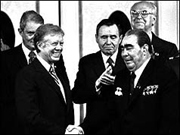 |
| President Carter and Mr Brezhnev at the Vienna Imperial Hofburg Palace |
| 1979: Leaders agree arms reduction treaty |
England have
United States President Jimmy Carter and Soviet leader Leonid Brezhnev have signed Salt II, the first arms-reduction treaty between the two super powers.
The Strategic Arms Limitation Treaty - agreed in Vienna - commits both sides to a limit of 2,400 missile launchers.
Negotiations for the deal followed Salt I signed by President Richard Nixon and Mr Brezhnev in 1972. It froze the deployment of land-based intercontinental ballistic missiles and banned the construction of any new submarine-based missiles.
The latest arms talks opened in Vienna, Austria, three days ago with a review of world problems causing severe strains on East-West relations.
Difficult circumstances
The session ended half-an-hour earlier than expected. Mr Brezhnev, lookingfrail, stumbled as he left the Soviet embassy and had to be steadied by President Carter.
However, discussions are reported to have proceeded well, US officials have noted "the absence of acrimony" and Mr Brezhnev's genuine interest in the proceedings.
They said Mr Brezhnev was making "a valiant effort to represent his country in difficult circumstances".
While Salt II deals largely with the limitation of nuclear weapon launchers, Mr Carter has also outlined plans for wide-ranging arms reduction negotiations over the next decade. Mr Brezhnev appears more concerned with reaching agreement on European troop cuts.
There have been other differences: the possibility that the US Senate may refuse to ratify the treaty has been an important concern at the summit.
Another key issue has been the range of the so-called Soviet Backfire bomber.
Mr Brezhnev has pledged that not more than 30 will be built each year and the range of its nuclear weapons will not be extended to reach the US.
Concerns have been raised in the US already by a member of the negotiating team, Lt Gen Edward Rowny, the Joint Chiefs of Staff representative. He claims the treaty gives the Soviets huge advantages in the number of thermonuclearwarheadson their land-based missiles - by a ratio of three to one.
|